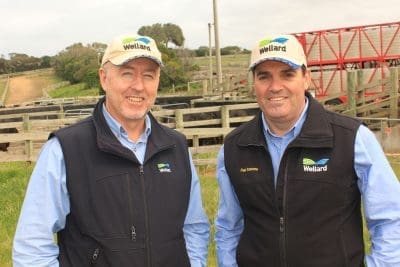
Wellards general manager China, Bernie-Brosnan (left), with executive director operations, Fred Troncone, at the Kobo feedlot.
AUSTRALIA’S largest livestock exporter Wellard Ltd is hoping a successful first shipment of slaughter beef steers to China will facilitate the issuing of feeder cattle import permits for the market.
Wellard yesterday loaded 1990 Angus and Angus Hereford steers from about 30 Victorian and South Australian producers for the 18-day trip on the Ocean Ute to the northern Chinese port of Shidao, near Tianjin.
The shipment is the largest from Australia since slaughter and feeder cattle protocols were signed with China in mid-2015 and follows three smaller air shipments and a sea consignment by Elders and the North Australia Cattle Co.
The mostly grass-fed 550-650 kg cattle will be supplied to Rongcheng HCMH Trade and Service Co. Ltd, a subsidiary of Tai Xiang Group, an established Chinese company specialising in frozen and processed food.
The steers were sourced on farms 3-4 weeks ago and delivered into quarantine at the Kobo feedlot near Portland 10 days ago. In China, they will be quarantined and then processed in a purpose-built facility which has been accredited under the Exporter Supply Chain Assurance Scheme (ESCAS).
Producers who sold cattle for the shipment said the 300c/kg price for their steers came at a time when domestic prices for similar cattle had dipped to 280-290c/kg. Other exporters are believed to be sourcing cattle for shipment while the current price and exchange rate conditions prevail.
Wellard China general manager Bernie Brosnan said the live slaughter trade to China would be sensitive to relative Australian cattle prices and exchange rates.
“Now that the Aussie-US dollar exchange rate is back around the high 70s – US77-78 cents – it has made it more affordable and the price for slaughter cattle in Australia has come off as well.
“Anything over 300c/kg (for 500-650kg cattle) and it would be extremely difficult, that’s why we haven’t been able to do anything for the last 12 months.”
Mr Brosnan said Wellard hoped to gain experience from this shipment to be ready for potential feeder cattle exports. Under Australia’s live slaughter cattle protocol with China, animals have to be slaughtered within 14 days of arrival, but this extends to 90 days under negotiated feeder cattle import rules.
“China needs to get a feeder market and have their own feedlots, because if you stay on the slaughter job, your business as an importer is subject to the volatility in the cattle price at this end and the exchange rate.
“Under the feeder protocol they have to be all slaughtered within 90 days, which would give you an average 70-75 days that you could value-add that feeder, so if there is a spike in price back here it gives them more viability in their business,” Mr Brosnan said.
Wellard executive director – operations Fred Troncone said the shipment was important to the industry and to the company as its first shipment under the new slaughter cattle protocol.
“We want to make this trial shipment an absolute success so that we can develop a more regular trade, grow our cattle exports to China and increase our vessel utilisation.
‘A more regular trade will also send a strong signal to cattle producers that there will be enduring demand for their quality livestock’
“A more regular trade will also send a strong signal to cattle producers that there will be enduring demand for their quality livestock,” he said.
Wellard has been a long-term supplier to China, supplying dairy and beef breeder cattle as well as airfreighting breeding sheep.
He said until recently Australian beef prices had made live slaughter cattle shipments to China uneconomical.
“In the last few months we’ve seen the Eastern Young Cattle Indicator come off a little bit so the price for cattle suitable for this trade has just come off,” he said.
Mr Troncone said the landed price for the Australian cattle needed to be competitive with Chinese cattle prices.
“We’re hoping that as we demonstrate that there no issues with this particular protocol that they will start to release permits under the feeder cattle protocol.
“Which of course then allows us to send cattle there that could held for longer periods of time before they are slaughtered,” he said.
Mr Troncone said a viable feeder cattle trade into China was also important for the productivity of the Chinese processing industry.
“The average turnaround time for a shipment going into China and back to Australia is somewhere between 30 and 35 days.
“So in reality a customer in China could only receive cattle every 30-35 days,” he said.
“The fact that they’ve got to slaughter them within 14 days means that they could be running an abattoir for 14 days and then it sits idle for the next 14 days while they are waiting for the next shipment to arrive.”
Mr Troncone said cattle sent under a feeder cattle protocol would mean the processing workload could be spread further. Chinese businesses have invested in feedlots within 50 kilometres of ports with nearby abattoirs.
“Those businesses have made significant capital investments in these assets, so of course they want to try to extract as much productivity out of them as they can.
“At the moment under the slaughter protocol it’s okay because they can start, they control the process, but I imagine that in the long-term they would want to get full productivity out of those assets which would mean they would like a continuous supply of cattle throughout the year.”
Producers grateful for new live trade competition
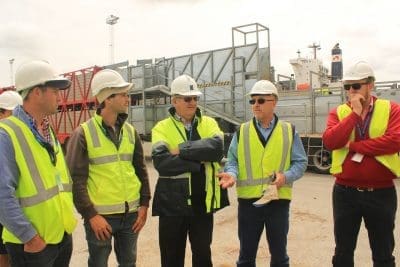
SA producers Will Truscott and Nigel Saint with Port of Portland project manager Graeme Tivey, Wellard general manager China, Bernie Brosnan and Elders Keith agent Dean Coddington.
South Australian cattle traders Trevor and Carol Norman said the trade had put a floor into the local market and kept domestic meat processors honest.
Elders Casterton agent Chad Mason said the live cattle shipment had come along at the right time when regional prices for 500-630kg cattle had come back to around 280-290c/kg.
“It has corrected the domestic market.”
Producer Glen Cameron said he supplied 70 steers for the shipment, which had “popped up at the right time.”
“I normally don’t have big fat steers, but this time I did; the season has been kind.
“It’s one more market and it sounds like they are going to be treated pretty well; there is quite a bit of control between here and processing — I like that,” he said.
TDC Penola agent Peter De Garis said more market competition was needed and several agency clients had supplied cattle for the shipment.
Echuca’s temporary bluetongue zone not a sourcing issue
Mr Troncone said the temporary bluetongue zone around Echuca had not been a sourcing issue for the Wellard shipment. The cattle for the shipment were sourced from Victoria and South Australia, well below the current National Arbovirus Monitoring Program bluetongue zone line which dissects the top of Western Australia, the Northern Territory, Queensland and north-west New South Wales.
“They are going into a fairly cold area of China, so there isn’t going to be an issue in terms of bluetongue.”
He said biosecurity issues had to be taken seriously and plans by other exporters to source cattle above the NAMP line would require more careful management.
Call for prompt NLIS transfers
Mr Brosnan said the cattle for the trade had to have a 90-day residency on the property of origin to be eligible for live export. He advised producers buying in cattle which might potentially be sold into the trade to do their transfer uploads to the National Livestock Identification System database as soon as possible.
“One of the most important things for this trade is if you receive cattle onto your farm, transfer immediately, the very next day.”
Careful attention must be given to withholding periods for any treatments, he said.
The veterinary surgeon travelling with the shipment, Dr Christopher Cooper, said the Ocean Ute’s capacity of 7000-7500 smaller cattle meant the 2000 steers would be given more space and ventilation to make them as comfortable as possible. A voyage now would not mean any wide temperature fluctuations for the cattle, he said.
“It’s as good a time as any.”
Port of Portland project manager Graeme Tivey said the port was looking forward to the trade developing for the area and to complement the existing breeder cattle shipments.
“We would like to build it up and make it one of the major exports here form the port.”
Mr Troncone said smaller shipments would dominate the initial live cattle trade between the two countries in the short term, but it had the capacity to increase significantly as the commercial landscape rebalanced. The shipment of cattle to China is a product of the Australia China Free Trade Agreement and the negotiation of health protocols between the two countries which took years to negotiate.
“Both governments should be congratulated on their foresight and willingness to open trade between the two countries.”

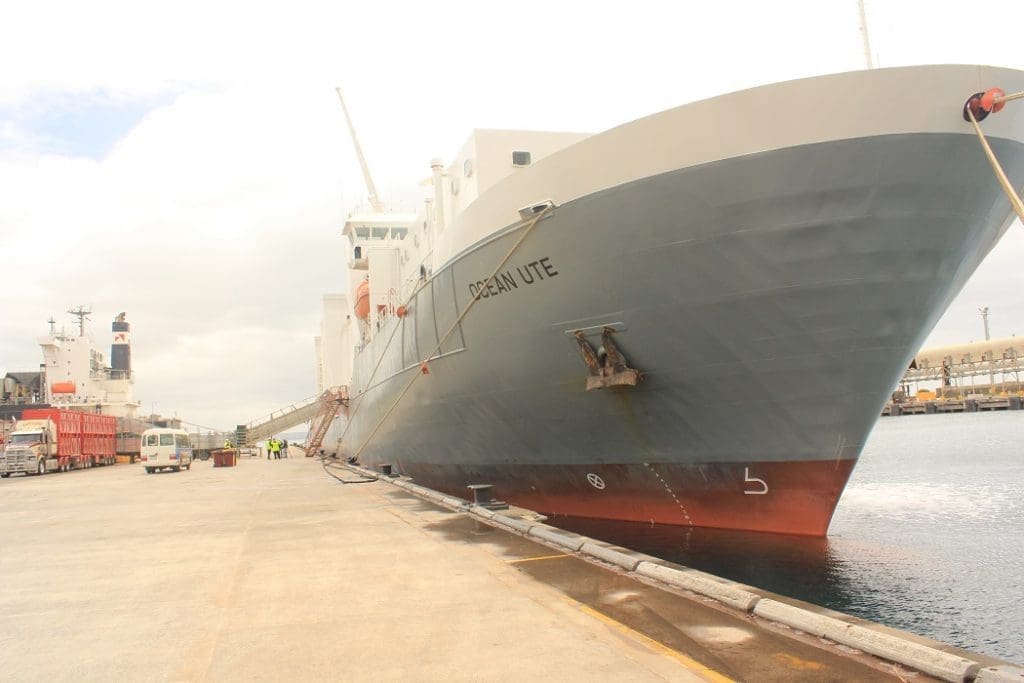
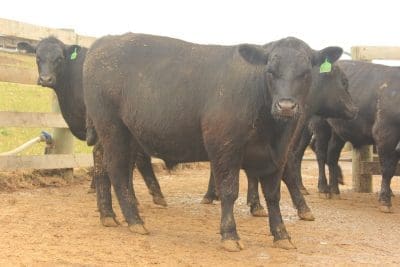
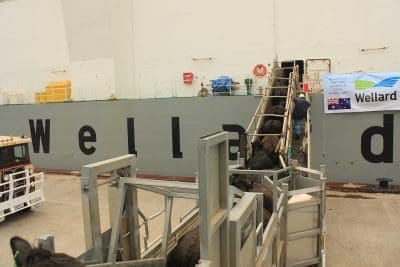


HAVE YOUR SAY